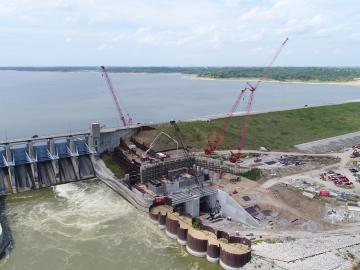
Filter News
Area of Research
- (-) Energy Science (50)
- (-) Supercomputing (12)
- Advanced Manufacturing (2)
- Biology and Environment (7)
- Computational Engineering (1)
- Computer Science (6)
- Electricity and Smart Grid (2)
- Functional Materials for Energy (1)
- Fusion and Fission (1)
- Isotopes (2)
- Materials (15)
- Materials for Computing (3)
- National Security (6)
- Neutron Science (6)
- Nuclear Science and Technology (3)
- Quantum information Science (4)
- Sensors and Controls (1)
- Transportation Systems (2)
News Type
News Topics
- (-) Cybersecurity (2)
- (-) Grid (17)
- (-) Machine Learning (5)
- (-) Quantum Science (4)
- (-) Space Exploration (4)
- (-) Transportation (33)
- 3-D Printing/Advanced Manufacturing (35)
- Advanced Reactors (3)
- Artificial Intelligence (7)
- Big Data (8)
- Bioenergy (5)
- Biology (5)
- Biomedical (7)
- Biotechnology (1)
- Buildings (18)
- Chemical Sciences (7)
- Clean Water (4)
- Composites (11)
- Computer Science (31)
- Coronavirus (6)
- Critical Materials (8)
- Energy Storage (34)
- Environment (26)
- Exascale Computing (4)
- Frontier (5)
- Fusion (2)
- High-Performance Computing (10)
- Hydropower (2)
- Isotopes (1)
- Materials (23)
- Materials Science (18)
- Mathematics (1)
- Mercury (1)
- Microscopy (5)
- Molten Salt (1)
- Nanotechnology (6)
- National Security (1)
- Neutron Science (3)
- Nuclear Energy (4)
- Partnerships (1)
- Physics (1)
- Polymers (9)
- Quantum Computing (5)
- Security (1)
- Simulation (5)
- Software (1)
- Statistics (1)
- Summit (7)
Media Contacts

A method developed at Oak Ridge National Laboratory to print high-fidelity, passive sensors for energy applications can reduce the cost of monitoring critical power grid assets.

To better understand the spread of SARS-CoV-2, the virus that causes COVID-19, Oak Ridge National Laboratory researchers have harnessed the power of supercomputers to accurately model the spike protein that binds the novel coronavirus to a human cell receptor.

A new Department of Energy report produced by Oak Ridge National Laboratory details national and international trends in hydropower, including the role waterpower plays in enhancing the flexibility and resilience of the power grid.

Fuel economy can take a tumble when temperatures plummet, according to the Department of Energy’s 2021 Fuel Economy Guide. Compiled by researchers at Oak Ridge National Laboratory, the guide includes several tips to improve a vehicle’s fuel performance.

Six scientists at the Department of Energy’s Oak Ridge National Laboratory were named Battelle Distinguished Inventors, in recognition of obtaining 14 or more patents during their careers at the lab.

If air taxis become a viable mode of transportation, Oak Ridge National Laboratory researchers have estimated they could reduce fuel consumption significantly while alleviating traffic congestion.

Kübra Yeter-Aydeniz, a postdoctoral researcher, was recently named the Turkish Women in Science group’s “Scientist of the Week.”

Oak Ridge National Laboratory researchers have developed a machine learning model that could help predict the impact pandemics such as COVID-19 have on fuel demand in the United States.

Burak Ozpineci of the Electrical and Electronics Systems Research Division at Oak Ridge National Laboratory has won the 2020 IEEE Power Electronics Society Vehicle and Transportation Systems Achievement Award.

Researchers at Oak Ridge National Laboratory developed a method that uses machine learning to predict seasonal fire risk in Africa, where half of the world’s wildfire-related carbon emissions originate.


